北京邮电大学 2019——2020 学年第一学期
《操作系统》期中考试试题
1. FILL IN BLANKS ( 10 points, 须用英文应答,中文答对得一半分)
(1) The device controller is responsible for moving the data between the peripheral devices that
it controls and its local buffer storage.
(2) Modern operating system is driven by interrupt .
(3) If an attempt is made to execute a privileged instruction in user mode, the hardware does
not execute the instruction but rather treats it as illegal and traps it to the operating system.
(4) Considering OS interfaces, an application program can utilize system calls to acquire
services provided by the OS.
(5) Programs loaded into and executing in memory refers to
process
. It needs certain
resources, including CPU, memory, files, and I/O devices to accomplish its task.
(6) Three general methods used to pass parameters to the operating system are registers,
memory block, and stack.
(7) In When CPU executes the instructions of operating systems, it is said that CPU is in
kernel / system / supervisor / privileged
mode.
(8) Two communication methods between processes are shared memory and message passing 。
(9) Operations on semaphores are initialization, wait() , and
signal() 。
(10) 3 conditions that a good solution for critical section problems should satisfy are Mutual
Exclusion, Progress
, and bounded waiting.
2. CHOICE ( 10 points )
(1)
D
A.PCB
is not included in the context of process?
B. code
C. kernel stack
D. interrupt vector
(2) Among the following migrations,
A. runningready
C. readyrunning
D
is impossible?
B. runningwaiting
D. waitingrunning
(3) When does a process migrate from waiting state to ready state? C
A. the process is waiting for an event
C. event that the process is waiting for occurs D. time slice is used up
B. process is selected by scheduler
(4) _ B _is the interval from the time of submission of a process to the time of completion.
A. Waiting time
B. Turnaround time
C. Response time
D. Throughput
(5) A starvation-free scheduling policy guarantees that no process waits indefinitely for service.
Which of the following scheduling policies is starvation free?
A. Round Robin
C. Shortest Job First
B. Priority
D. None of the above
A
1/6
�
(6) In multiprogramming system, in order to guarantee the integrality of shared variable,
processes should enter their critical section mutual exclusively. Critical section refers to
C
A. a buffer
C. a code segment
B. a data segment
D. synchronous mechanism
.
(7) A deadlock situation can arise if the four necessary conditions hold simultaneously in a
system. Which one of the following is not the necessary conditions? C
A. mutual exclusion
B. hold and wait
C. preemption
D. circular wait
(8) Which handling procedures of the following situations will not switch into monitor mode?
A
A. procedure calls B. system calls
C. interrupts
D. traps
(9) In operating systems, the semaphore stands for instances of resource, it is a integer variable
relevant to a queue ,its value can only be changed by operation wait() and signal(). If a
semaphore S is initialized to 5, now it’s value is 2, how many processes is or are waiting in
the queue relevant to S. D
A. 3
C. 1
D. 0
B. 2
(10) In the following comments on processes and threads, only
B
are correct.
① As the result of I/O completion, a process switches from the waiting state to the ready
state, and the CPU scheduling may take place.
② In a system with the operating system supporting kernel-level threads, the process is the
basic unit for resources allocation, while the thread is the basic unit for CPU scheduling.
③ For several threads created by one process, one thread’s stack and registers can be
shared by the others.
④ The round robin algorithm will never result in process starvation.
⑤ PCB contains the process state, the program counter, CPU registers, and user data.
A. ① ② ③
C. ② ③ ⑤
B. ① ② ④
D. ② ④ ⑤
3(. 12 points)In a system with 2 processors, there are 10 concurrent processes sharing a type of
resource based on a semaphore S,
(a) only one process is permitted to enter its critical section to use the resource, or
(b) at most 3 processes are allowed to enter theircritical sections to use the resource,
then answer the following questions.
if each time,
(1) in these two cases, what are the initial, maximum, and minimum values for the semaphore
S respectively?
Case
(a)
(b)
initial value
maximum value
minimum value
1
3
1
3
-9
-7
(2) what are the maximum, and minimum numbers of processes in ready, running, and waiting
state?
number of processes
ready
running
waiting
maximum
minimum
8
0
2
0
10
0
2/6
�
4.(10 points)In a computer system with only one processor, one input device and one
printer. Processes A and B enter the system sequentially at time 0, and A is scheduled by the
CPU scheduler at first. The execution tracks of A and B are as follows:
A: CPU burst lasting 20ms, then I/O burst of 100ms on the input device, and then CPU burst
lasting 50ms, exiting.
B: CPU burst lasting 40ms, then I/O burst of 70ms on the printer, and then CPU burst lasting
30ms, exiting.
(a) Suppose that preemptive SJF scheduling algorithm (SRTF) is employed, draw the Gantt
chart to describe the resource usage of A and B on the CPU, the input device and the printer.
(b) Calculate the waiting time and turnaround time for process A and Brespectively.
Answer:
(1)
(2)
for process A:
waiting time:
30ms
turnaround time:
200 ms
for process B:
waiting time:
20ms
turnaround time:
160 ms
5.(20 points) Consider the following set of processes, their arrival time, CPU burst time, and
priority numbers are as following.
The length of the CPU burst given in millisenconds, and larger priority numbers imply higher
priority.
Process Arrival Time Burst Time Priority number
0
1
2
4
5
3
3
6
P1
P2
P3
P4
1
3
7
5
(1). Suppose that priority-based preemptive scheduling is employed,
(a) Draw a Gantt chart illustrating the execution of these processes;
(b) Calculate the average waiting time.
(c) Calculate the average turnaround time.
(2). Suppose that priority-based non-preemptive scheduling is employed,
(a) Draw a Gantt chart illustrating the execution of these processes;
(b) Calculate the average waiting time.
(c) Calculate the average turnaround time.
3/6
�
(1) preemptive priority scheduling algorithms.
(a)
(b) the average waiting time:
(c) the average turnaround time:
(12+9+0+1)/4=5.5
(17+12+3+7)/4=9.75
(2) non-preemptive priority scheduling algorithms:
(a)
(b) the average waiting time:
(c) the average turnaround time:
(0+13+3+4)/4=5
(5+16+6+10)/4=9.25
4/6
�
6. (20 points ) There is a plate that can hold only one apple or can hold three oranges. Father
put an apple once a time into the plate; mother put an orange once a time into the plate. If
there is already one or two oranges on the plate, the mother can put another orange into the
plate.
Son takes an apple from the plate and eats. Daughter takes an orange from the plate once a
time and eats.
The processes for the father, mother, son, and daughter are shown as followings.
In order to synchronize these processes, please design semaphores and complete these
processes by using wait() and signal() operations on semaphores.
(1) Define semaphores needed and initialize them.
SEMAPHORES
Splate=1;
Sapple=0;
Sorange=0;
MUTEX_OC=1;
MUTEX_MD=1;
Orange_ROOM=3; Used to record the rooms left for keeping oranges.
Used for mutual exclusion use of the plate.
Used for synchronization between the process father and son.
Used for synchronization between the process mother and daughter.
Used for mutual exclusion operation on variable orange_count.
Used for mutual exclusion operation on plate between mother and daughter.
VARIABLE
orange_count=0; Used to record the number of oranges kept in the plate.
(2) Write appropriate code segmentation for each place marked by number from (1) to(8).
Father:
while(true){
(1) wait(Splate);
(2)
Put an apple into the plate;
signal(Sapple);
}
Mother:
while(true){
5) wait(orange_ROOM);
wait(MUTEX_OC);
orange_count++;
if (orange_count==1) wait(Splate);
signal(MUTEX_OC);
wait(MUTEX_MD);
Put an orange into the plate;
signal(MUTEX_MD);
signal(Sorange);
(6)
}
Son:
while(true){
(3) wait(Sapple);
Take the apple from the plate;
signal(Splate);
eats the apple;
(4)
}
Daughter:
while(true){
(7) wait(Sorange);
wait(MUTEX_MD);
Take an orange from the plate;
signal(MUTEX_MD);
(8) wait(MUTEX_OC);
orange_count--;
if (orange_count==0)
signal(Splate);
signal(MUTEX_OC);
signal(orange_ROOM);
eats the orange;
}
5/6
�
7. (18 points) For the system described in the table below
process
Current
allocation
Maximum
needs
outstanding
requests
R1
2
1
0
0
P1
P2
P3
P4
R2 R3 R1 R2 R3 R1
0
0
2
0
0
1
0
1
0
5
4
0
1
2
2
1
0
0
1
1
2
2
1
2
R2 R3
1
0
0
1
0
0
0
0
Available
R1
0
R2
2
R3
0
(1) How many instances are there for each type of resources?
Total resources in the system are (R1, R2, R3) = (3, 5, 2),
(2) Draw the resource-allocation graph
(3) Is the system in a safe or unsafe state? Specify your judgingprocedure.
System is in an unsafe state
Need=
R1
0
1
1
2
P1
P2
P3
P4
needs
R2
0
3
3
0
R3
1
2
1
0
Resources available=(0, 2, 0) can not satisfy the requirements need from any processes, so
there exists no safe sequence of processes, so system is in an unsafe state.
(4) Is the system deadlocked? Specify your judging procedure.
System is not deadlocked.
According to deadlock detection algorithm,
Work=(0,2,0) finish[i]=false for i=1,2,3,4
Because request3=(0,0,0)
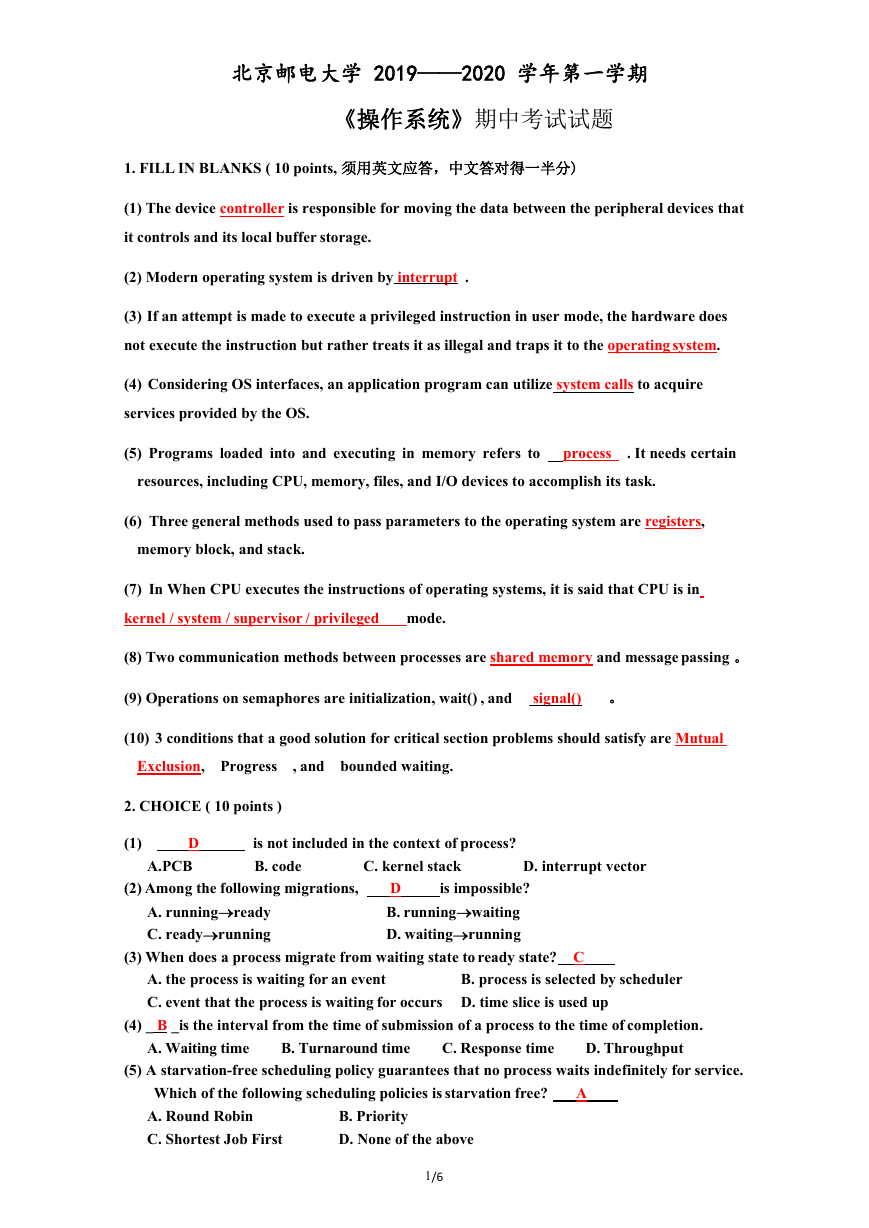
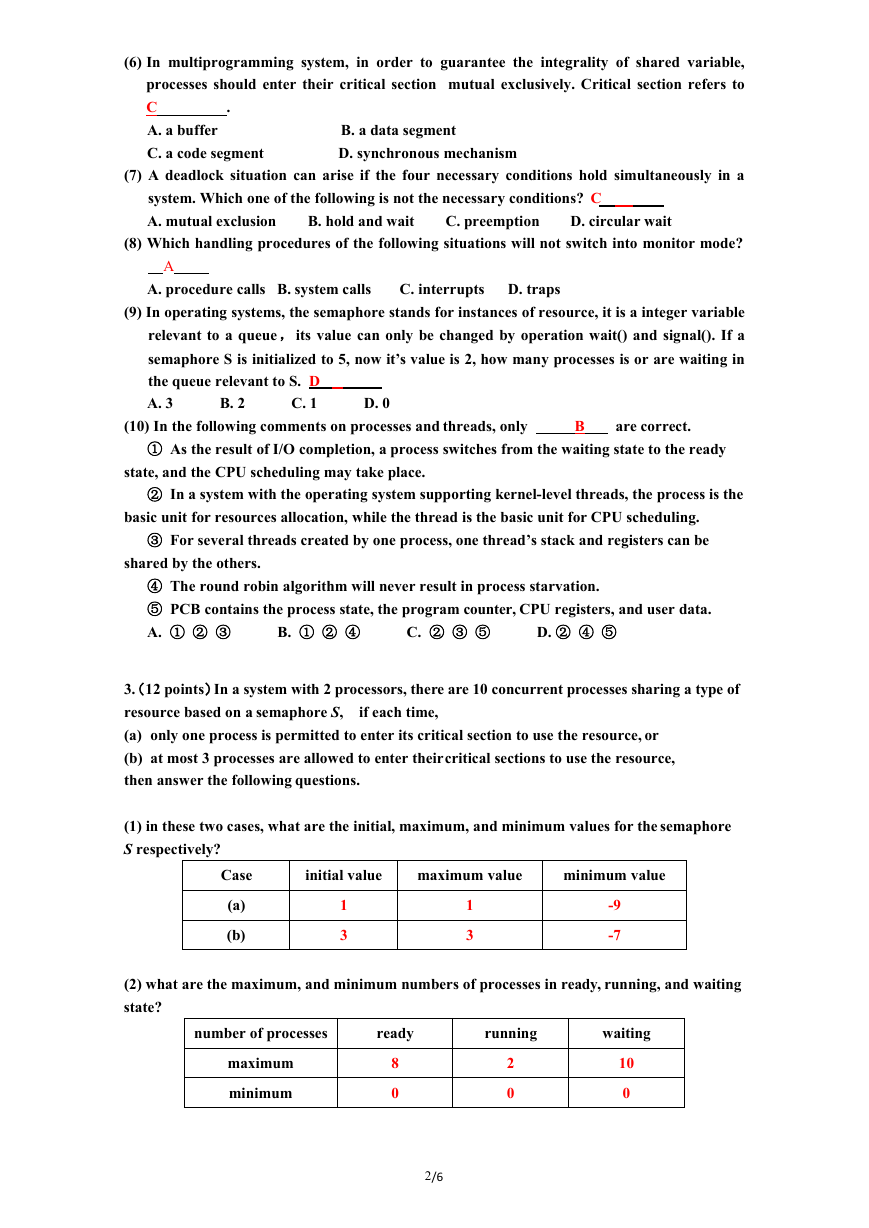
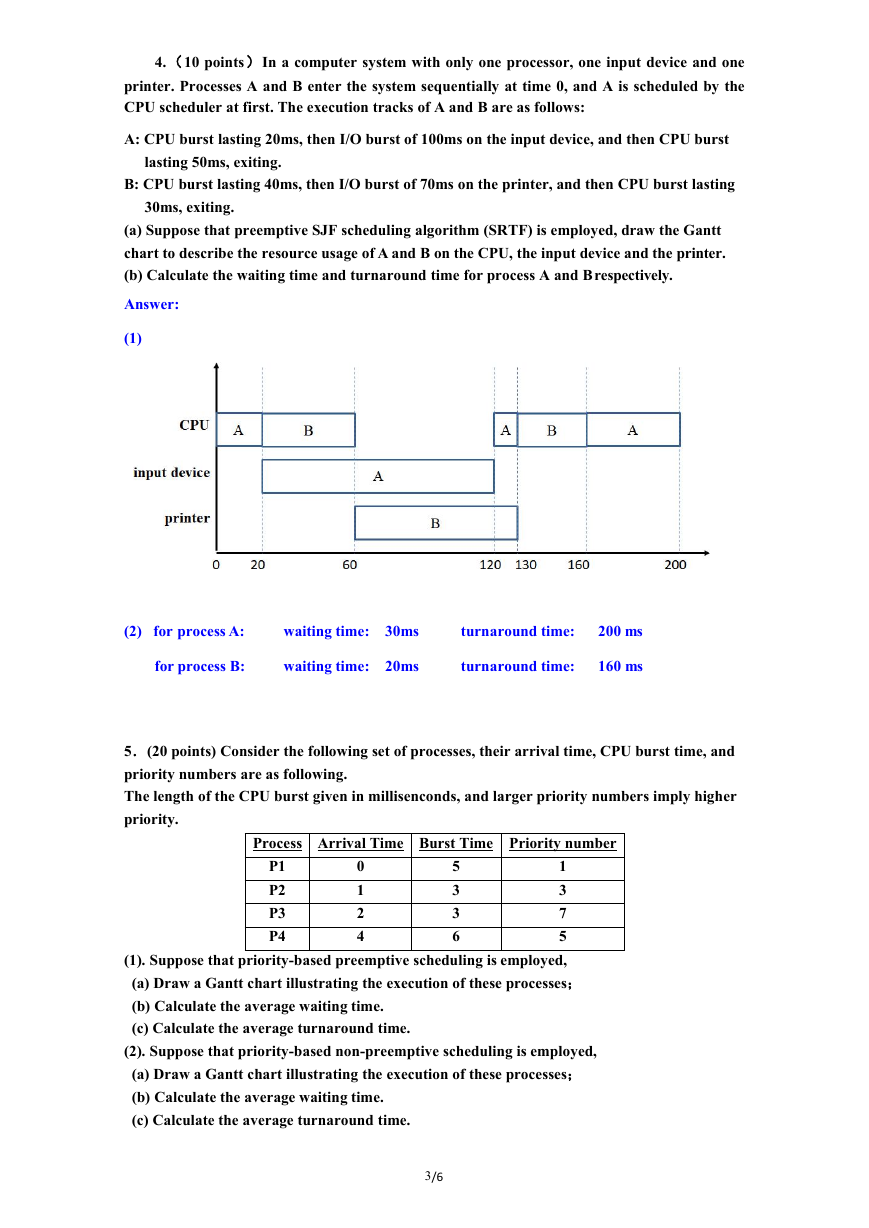
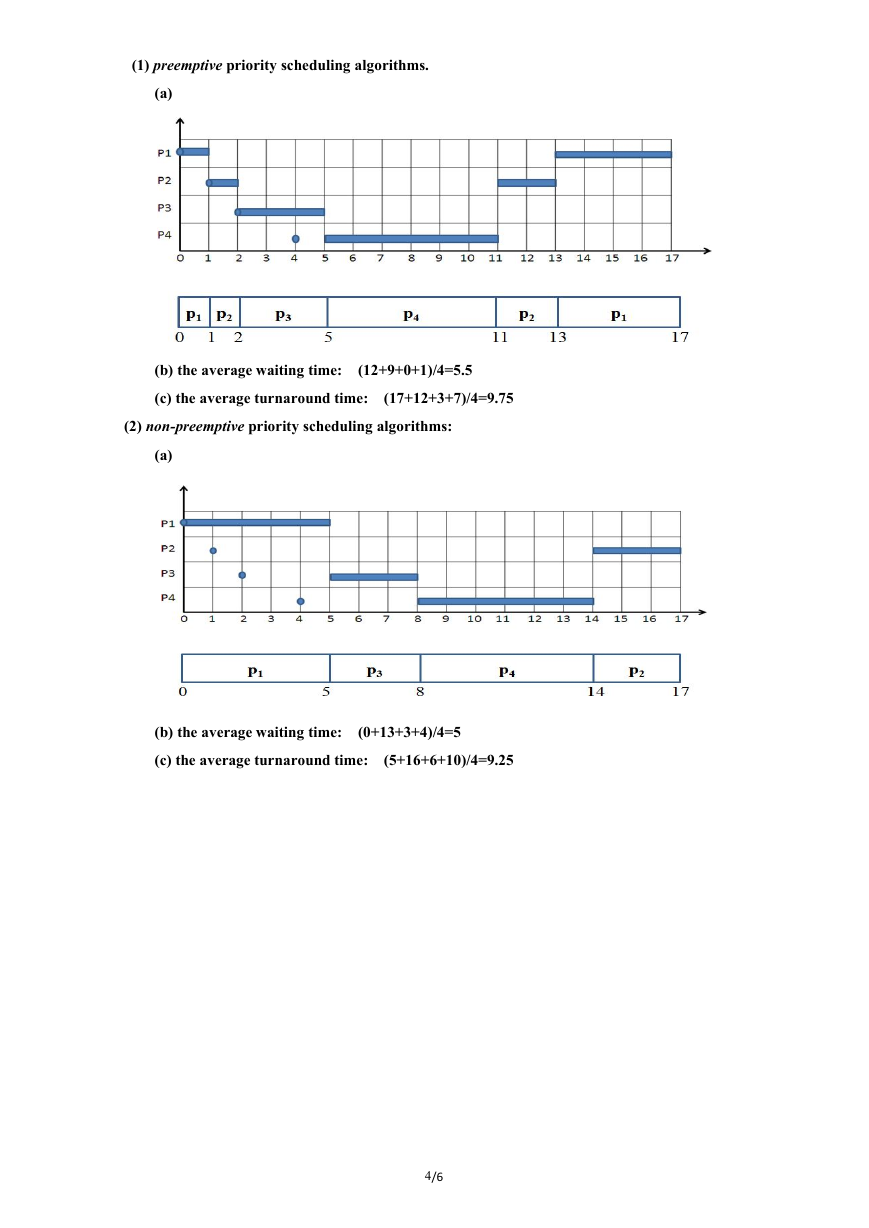
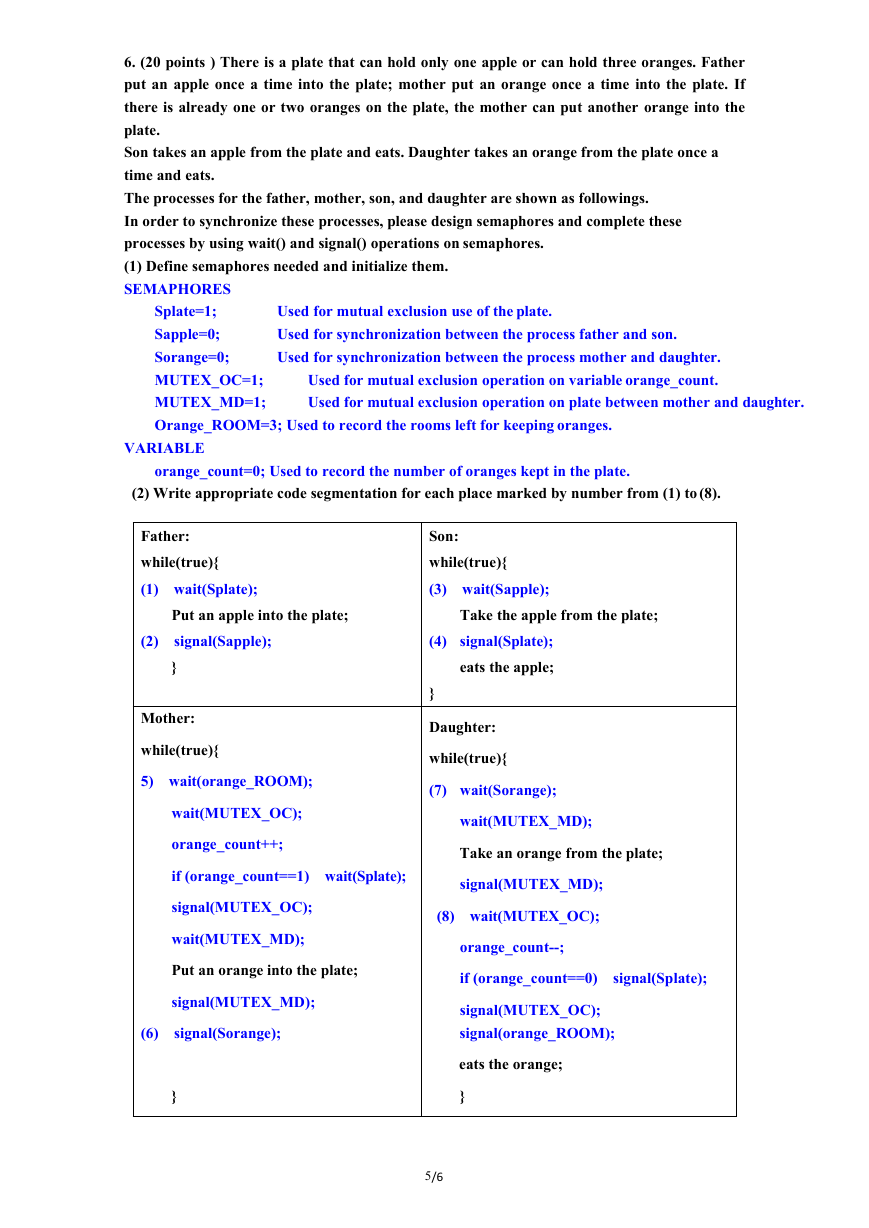
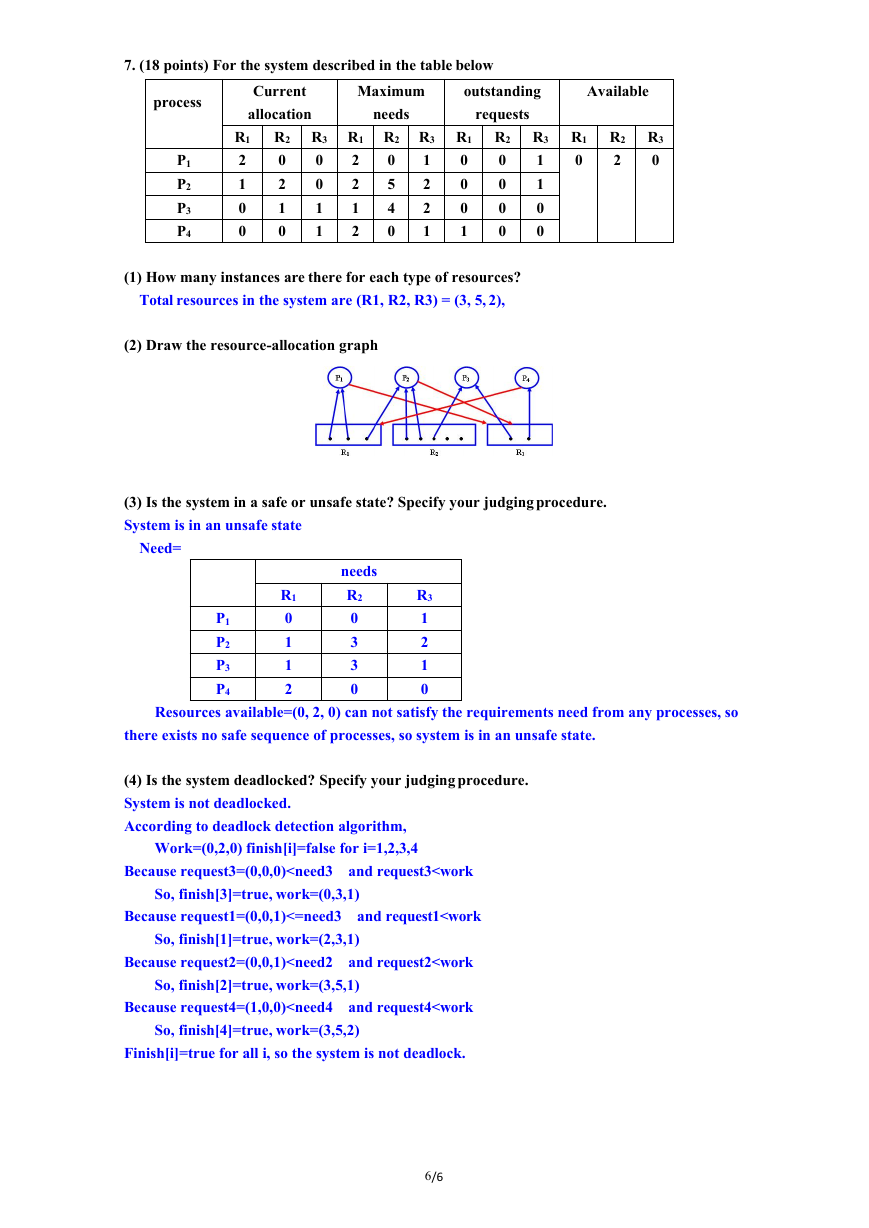






 2023年江西萍乡中考道德与法治真题及答案.doc
2023年江西萍乡中考道德与法治真题及答案.doc 2012年重庆南川中考生物真题及答案.doc
2012年重庆南川中考生物真题及答案.doc 2013年江西师范大学地理学综合及文艺理论基础考研真题.doc
2013年江西师范大学地理学综合及文艺理论基础考研真题.doc 2020年四川甘孜小升初语文真题及答案I卷.doc
2020年四川甘孜小升初语文真题及答案I卷.doc 2020年注册岩土工程师专业基础考试真题及答案.doc
2020年注册岩土工程师专业基础考试真题及答案.doc 2023-2024学年福建省厦门市九年级上学期数学月考试题及答案.doc
2023-2024学年福建省厦门市九年级上学期数学月考试题及答案.doc 2021-2022学年辽宁省沈阳市大东区九年级上学期语文期末试题及答案.doc
2021-2022学年辽宁省沈阳市大东区九年级上学期语文期末试题及答案.doc 2022-2023学年北京东城区初三第一学期物理期末试卷及答案.doc
2022-2023学年北京东城区初三第一学期物理期末试卷及答案.doc 2018上半年江西教师资格初中地理学科知识与教学能力真题及答案.doc
2018上半年江西教师资格初中地理学科知识与教学能力真题及答案.doc 2012年河北国家公务员申论考试真题及答案-省级.doc
2012年河北国家公务员申论考试真题及答案-省级.doc 2020-2021学年江苏省扬州市江都区邵樊片九年级上学期数学第一次质量检测试题及答案.doc
2020-2021学年江苏省扬州市江都区邵樊片九年级上学期数学第一次质量检测试题及答案.doc 2022下半年黑龙江教师资格证中学综合素质真题及答案.doc
2022下半年黑龙江教师资格证中学综合素质真题及答案.doc